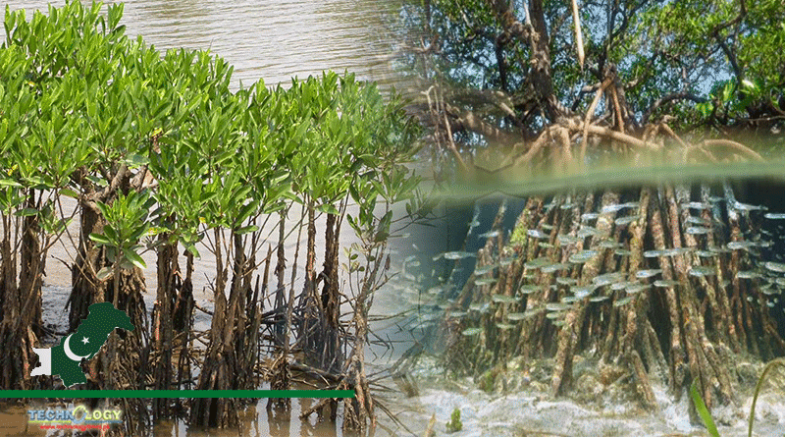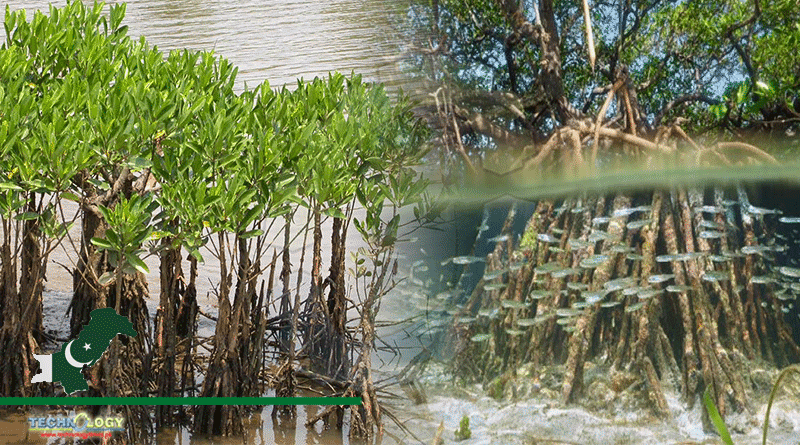Study reviews the growth of mangroves from 1990 to 2020 in five geographical pockets: Indus delta, Sandspit, Sonmiani Khor, Kalmat Khor and Jiwani.

The mangrove cover on Sindh’s coastal belt, more precisely in the Indus delta, has increased by 986.36 square kilometres (km) during the past 30 years, growing by an average of 3.74 per cent annually, a study has revealed.
Jointly conducted by the Institute of Space Technology, World Wide Fund for Nature-Pakistan (WWF-P) and Society for Environment and Mangrove Protection Welfare Association, the study reviews the growth of mangroves from 1990 to 2020 in five geographical pockets, classified as the Indus delta, Sandspit, Sonmiani Khor, Kalmat Khor and Jiwani.
Over the years, multiple studies have shown mangrove forests around the world are disappearing, the erasure being recorded at two per cent annually on average.
In Pakistan too, four of eight indigenous mangrove species have gone extinct.
Previously, Bruguiera conjugata, Ceriops tagal, Ceriops roxburghiana, Rhizophora apiculata, Rhizophora mucronata, Aegiceras corniculatum, Avicennia marina, and Sonneratia caseolaris – all species of mangroves – were found in Pakistan. Of these, Bruguiera conjugata, Ceriops roxburghiana, Rhizophora apiculata and Sonneratia caseolaris have disappeared.
This disappearance is mainly due to climate change and anthropogenic activities – human activities that affect the environment.
The study identifies camel grazing, fuelwood extraction and overfishing as common anthropogenic activities that threaten mangrove conservation practices in Pakistan.
“However, Pakistan has managed to visibly increase its mangrove cover over the last 30 years and it is the only country to be able to do so,” one of the authors of the study, WWF-P senior director Dr Masood Arshad, told The Express Tribune.
“Mangroves covered an area of 477 square km in 1990 in Pakistan and have now expanded to cover 1,463 square km. This is a 300 per cent increase.” Dr Arshad further said that 95 per cent of mangrove forests in the country were in the Indus delta in Sindh.
According to WWF-P director in Sindh and Balochistan Dr Tahir Rasheed, the Sindh government has contributed the most to this mangrove gain. Acknowledging that many NGOs had also contributed to protecting and planting mangroves, he said the provincial government played a big role in this regard and “sincerely” contributed to increasing the mangrove cover.
Indus delta
The Indus delta, situated in Thatta district, comprises 17 major creeks and various other minor creeks. Besides, the delta is also home to 95 per cent of Pakistan’s estuarine mangroves.
According to the study, the mangrove forest in the delta has shown a continuous growth of mangroves, covering an expanse of 86.4 square km in 1990 and extending over 734.1 square km in 2020.
Sandspit
In comparison, the mangrove cover has expanded at a much slower rate at Sandspit, with the forest area growing by just 1.48 square km between 1990 and 2020. In fact, the forest area had actually reduced from 12.09 square km to 9.79 square km between 1990 and 1995. Since then, the forest showed marginal growth of mangroves, growing to cover just 0.95 square km more by 2000.
Sonmiani Khor
The picture, however, was drastically different in Sonmiani Khor, where the mangrove forest grew to cover 42.80 square km by 2020 from 14.80 square km in 1990.
Kalmat Khor
In Kalmat Khor, where mangroves covered an area of 3.78 square km in 1990, the forest cover reduced to 2.77 square km by 1995. However, by 2000, the trees covered an expanse of 3.61 square km and the forest cover has continued to grow since them without any decline.
Jiwani
In Jiwani, mangroves cover an area of 2.23 square km at present. There, the forest has grown by 3.39 per cent on average annually, with the overall increase in forest cover adding up at 1.43 square km over the past 30 years.
‘Natural fortresses’
The ability of mangroves, colloquially called ‘timar’, to sequestrate – absorb carbon dioxide from the atmosphere and store it as biomass in the soil – is 18 times that of other trees.
Resultantly, mangrove forests are one of the most productive ecosystems on earth, also useful for climate change mitigation and adaptation. They act as natural fortresses, providing protection against tsunamis and cyclones, in addition to contributing towards keeping creeks and water channels clean by acting as a buffer against sea intrusion and soil erosion.
Originally published at Express Tribune
